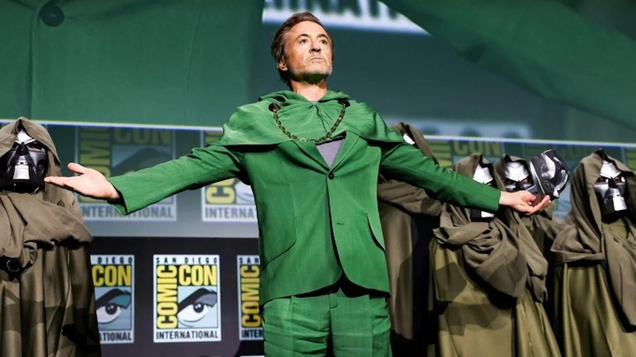Leave the World Behind
Estimated reading time: 7 minutes
Leave the World is now playing in select theaters and begins streaming on Netflix Friday, December 8.
Based on Rumaan Alam’s 2020 book of the same name, Leave the World Behind zig-zags in a number of intriguing directions but ends up unable to bear the weight of its own lofty ideas. Led by a stellar ensemble and written and directed by Mr. Robot creator Sam Esmail, the film traverses both personal and political paranoia in its tale of a family vacation gone awry. However, its attempts to weave meaningful reflections on modern America end up so flimsy and half-baked that the whole thing simply crumbles by the closing credits, with one of the most head-scratching final scenes and needle drops in recent memory.
We’re thrown into the plot just as suddenly as New Yorker Clay Sandford (Ethan Hawke) is. A fairly well-off, middle-aged father of two, he wakes up to find that his wife, Amanda (Julia Roberts), has not only booked the whole family a weekend getaway on Long Island, but has packed their bags as well. The easygoing Clay is left with no option, especially when the sardonic, uptight Amanda practically states her reason for wanting to escape the city directly to the camera, as it crash-zooms in on her: “I fucking hate people.”
It’s a wry and appropriately cheesy introduction to a film that deftly twists its screws, at least initially. As Clay, Amanda, their teenage son Archie (Charlie Evans), and their younger daughter Rose (Farrah Mackenzie) relax on their first day at a fancy homestay, an apparent internet, phone, and cable outage prevents Rose from watching the finale of the ’90s sitcom Friends – her new TV obsession, and a surprisingly big part of Leave the World Behind’s plot and even its worldview – though the family thinks little of it, and even considers the inadvertent isolation a blessing. That is, until night falls, and the white family is met with a pair of sharply dressed Black strangers – George “G.H.” Scott (Mahershala Ali) and his adult daughter Ruth (Myha’la) – who arrive at the door claiming to be the house’s owners, trying to talk their way inside with a story of a dangerous citywide blackout in NYC.
An initial premise not too dissimilar from the first act of Barbarian – in which two strangers end up booking the same Airbnb – sets up character-centric intrigue through fine-tuned performances from masters of their craft. As Clay, Hawke tries to politely diffuse this strange situation, tip-toeing his way through careful de-escalation without offending his apparent hosts, but Roberts remains on edge as Amanda, a woman far less trusting and welcoming than her husband. Ali approaches G.H. with an impeccable sense of duality, playing not only a man with hidden layers (which we see unearthed as the camera captures details the Sandfords don’t initially see), but also playing the object of Amanda’s fears. G.H. is intimidating in one moment and gentle in the next, but Ali ensures that the difference between these two modes is razor thin.
Unfortunately, Myha’la is saddled with an awkward responsibility. As Ruth, a young, Black, Gen Z adult, she’s painted with the boisterous hues of someone always on the attack, and looking for a reason to put her flimsy theories into practice. Myha’la’s performance is certainly precise – she does an impeccable job when the character’s own dramatic layers are eventually revealed – but Esmail’s writing betrays her on occasion. She becomes the mouthpiece for Leave the World Behind’s lingering questions of the Sandfords’ possible racial biases, as if they (and the POV of white fragility they accompany) weren’t already obvious. What’s more, little interest is expressed in unpacking this dynamic, especially as the plot begins swerving and expanding in scale to include haphazard commentary on the flimsy threads holding American society and culture together.
While Leave the World Behind begins as a COVID-era chamber piece, the goings-on around the house grow increasingly bizarre, from uncanny animal sightings to strange noises in the distance. During this buildup, Esmail and cinematographer Tod Campbell create a sense of lurid amusement with the way they swing the camera through space. They create a danger and momentum as the ostentatious incidents in the vicinity pile up, leaving the Sandfords and the Scotts with only a sliver of the entire picture.
Things also adequately slow down in order to circle back to Amanda’s “I fucking hate people,” proclamation, forcing not just her, but all four adults into a scenario where their loyalties and selfishness are put to the test. In its best moments, the film becomes a focused thriller about how best to keep one’s loved ones safe – is self-reliance the answer? Or is it community? – though this dilemma often ends up taking overly convenient form in order to make the plot more pliable. Beyond a point, the question of “How much terrifying information should one reveal to children?” only serves to drive frustrating wedges between the characters. They only have parts of the puzzle, and while the audience isn’t let in on the bigger picture, we know more than any one of them do at any given moment. This makes a number of their decisions frustrating to witness, as though they were being guided not by human instinct, but by plot considerations, making decisions that further extend the runtime, rather than choices that might better serve the drama at hand. No wonder Leave the World Behind is 2 hours and 21 minutes long, despite having the momentum and disposition of a slick 90-minute thriller.
Leave the World Behind’s reflections on modern America are so half-baked the whole thing simply crumbles by the closing credits
It doesn’t help that the Sandfords’ children – the center of the couple’s moral quandaries – are weakly written. Both Evans and Mackenzie seem fairly capable as actors, but Archie is practically a non-character whose only function is to respond boorishly to his sister’s concerns. Rose, much like Ruth, is shouldered with espousing Esmail’s thoughts on modern television of all things, which comes off trite at best.
Just when it seems like Leave the World Behind might be headed towards particularly challenging territory – a top-down look at why American society has taken the shape it has for the last 20-some years, and how this has finally come back to bite it in the ass – it stops short of doing anything fun, thrilling, or remotely interesting with this theme. Instead, it simply treats the recognition of base political ideas as a revelation in and of itself, as though observing social phenomena at a distance were as compelling as engaging with them visually or dramatically.
This also leads to an ending that appears pretty much out of nowhere, with a needle drop that – despite being set up in a dozen different ways – feels so sudden and ridiculous that it might be poised as the next meme exploring what various movie climaxes would look like if they were made in 2007 and set to Linkin Park. That this final exclamation point feels like a punchline is nothing if not an indicator of Leave the World Behind’s wasted potential.









